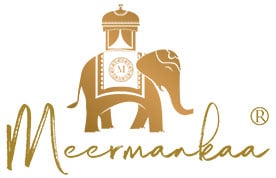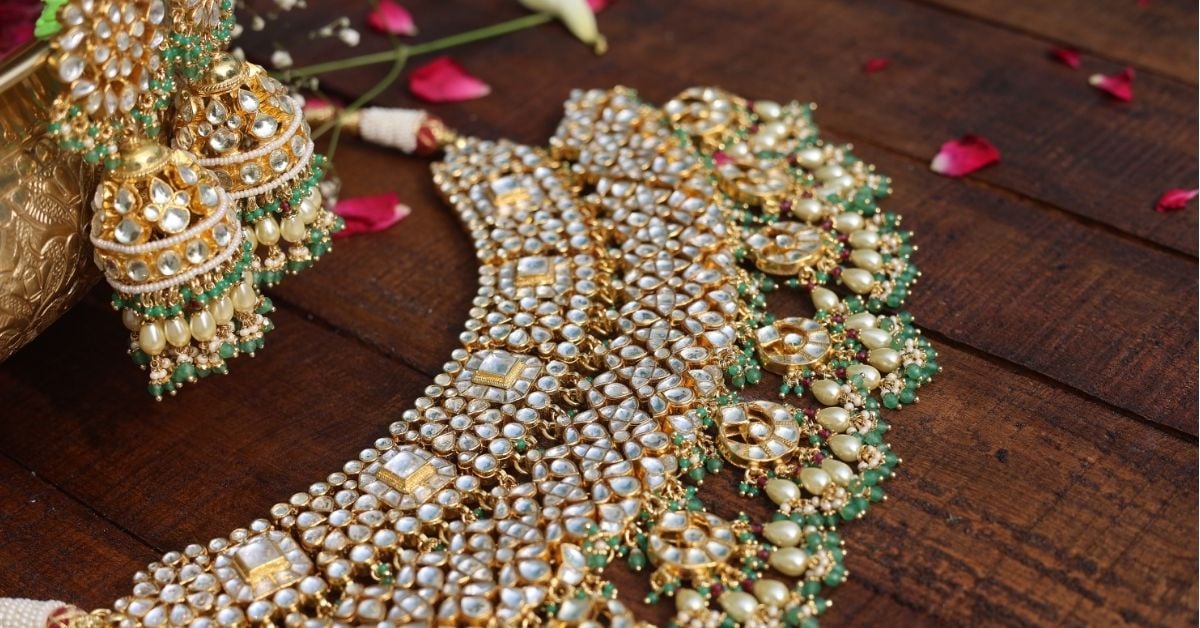Style
11 Types of Indian Bridal Jewellery
You want to look unforgettable on your wedding day, and the right jewellery brings everything together. It’s not just about tradition or style. It’s about choosing pieces that reflect who you are and the day’s meaning for you. Indian weddings are rich in detail, and your jewellery plays a powerful role in every moment.
This blog will help you understand the different types of bridal jewellery that form the core of your bridal wardrobe. From classic designs to statement-making accessories, each piece adds beauty and balance to your look.
Traditional vs. Modern Wedding Jewellery
Traditional jewellery focuses on heritage. You see it in heavy gold sets, detailed temple motifs, and regional techniques like meenakari and polki. These pieces are deeply rooted in rituals, often passed down from generation to generation. If your ceremony leans into tradition, these sets are a natural fit.
Modern styles offer flexibility. Today’s bridal collections offer lighter materials, streamlined designs, and reusable pieces if you want comfort without compromising elegance. You’ll find statement chokers with Moissanite Polki or a silver necklace and earring set that works for both your wedding and future events.
No rule says you must choose one or the other. Mixing both traditional and modern jewellery can help you create a look that feels personal while still honoring your culture.
Indian Bridal Jewellery Names
1. Necklace (Haar)
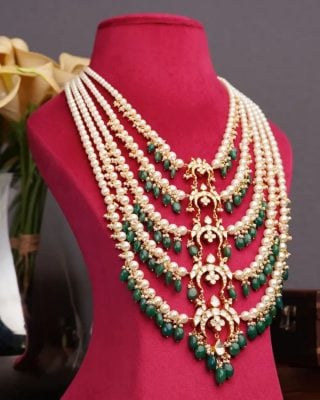
No bridal look is complete without a necklace. It’s the centerpiece of your entire jewellery set. From long haram to rani haar to layered choker, your choice here makes a strong statement.
Traditional sets feature uncut diamonds or kundan work. You might opt for a Moissanite necklace if you’re looking for brilliance without the weight or cost of diamonds. It gives you elegance and comfort in equal measure.
A silver choker necklace can also enhance your outfit, especially with lighter lehengas or pastel sarees. Layered necklaces are a popular choice for adding depth and style to your bridal look. You can mix long and short necklaces to create a rich, elegant appearance. Layering multiple styles is common, just make sure they match in tone and detail.
Also Read: Which Are the Best Earrings for a Round Face?
2. Earrings
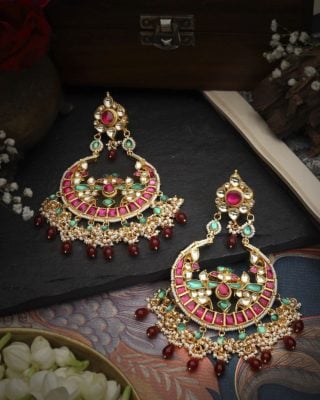
Your earrings frame your face and show up in nearly every photo. Whether you’re wearing your hair up or down, your earrings should complement your hairstyle and necklace.
Chandbali and jhumkas remain timeless. If you’re going traditional, look for pieces in gold or with polki detailing. You can also explore different types of jhumkas to match your outfit, from lightweight designs to bold statement pairs. You can go bold with heavy earrings if the rest of your jewellery is subtle. On the other hand, smaller pieces with delicate design work best when your necklace is already making a strong impression.
3. Maang Tika and Matha Patti
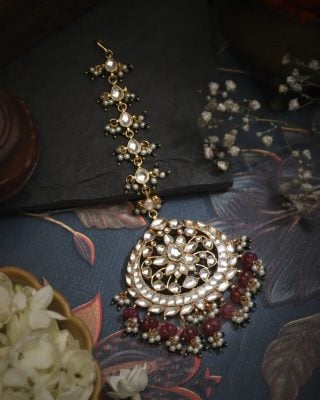
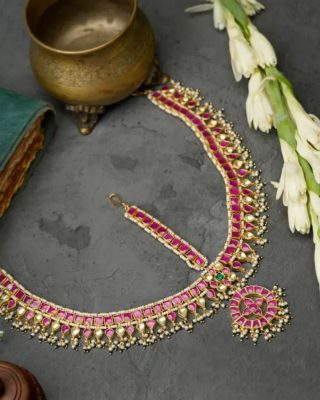
Kamal Mangtikka Gauri Maathapatti
Maang Tikka on your forehead, right at the parting of your hair. It’s one of the most iconic items in Indian weddings. A maang tika can be simple or ornate, depending on your look. If you’re going grand, a matha patti, with chains that run along your hairline, gives extra detail.
Polki and kundan work are often seen in these pieces. For something lighter, try a design in Moissanite or pearls. It draws attention to your face, especially during rituals and close-up photos.
Whether you choose a full mathapatti or a single-string piece, make sure it stays in place. A well-chosen tika balances your hairstyle and completes your bridal makeup beautifully.
Also Read: Best Necklaces to Wear with Boat Neck Outfits
4. Bangles (Choodiyan)
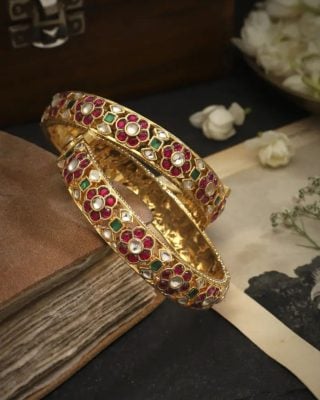
Bangles are more than decoration. They hold cultural meaning. You wear them in layers, often mixing colors, textures, and metals. This is where your bridal hand jewellery truly shines. Combine glass bangles with gold-plated kadas or pearl-embellished styles. To add sparkle, include Moissanite bangles that catch the light as you move.
Traditional brides often wear red-and-white choodas or gold sets passed down through the family. Modern brides experiment with color schemes that match their outfits. Just remember: comfort matters. You’ll wear these for hours, so choose a mix that feels as good as it looks.
5. Nose Ring (Nath)
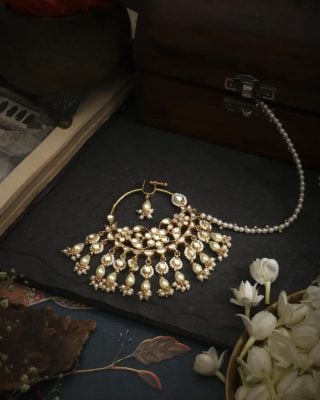
A nose ring is considered an important accessory for Indian brides. Whether it’s a tiny stud or a large, bold hoop with a chain, each piece makes a statement.
Some brides go for minimal styles. Others want a dramatic gold-plated hoop with pearls or kundan. Clip-ons are available if you don’t have a piercing. You can also find versions in polki bridal jewellery styles that match your necklace or earrings.
Understanding the benefits of nose piercing helps you see why this accessory is not just decorative but also a traditional choice that enhances your bridal look. Wear this for your main ceremony, especially if your outfit is more traditional. It adds character, depth, and elegance to your entire look.
Also Read: 8 Differences Between Kundan and Polki Jewellery
6. Anklet (Payal)
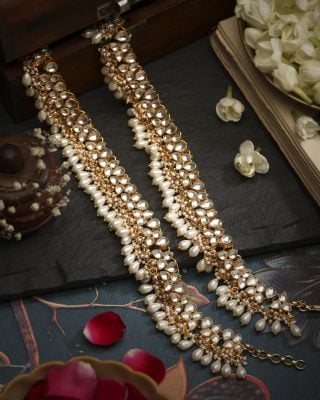
Anklets are beautiful pieces of jewelry worn around the ankle. Silver anklets are very popular, but you’ll find gold-toned options too. Designs range from fine chains with minimal accents to thicker styles with small bells or engraved charms.
Whether you go traditional or modern, this piece connects your look from head to toe. It’s a small detail, but it makes a lasting impression. Anklets is one of the quieter pieces in the indian bridal accessories list, but it adds meaning to the bridal look.
7. Bajubandh (Armlet)
Worn on the upper arm, the bajubandh adds balance, especially if your blouse has short sleeves or none at all. Common in South Indian and Rajasthani bridal styles, it brings structure to your upper silhouette.
Classic versions feature gold filigree or temple-style patterns. Modern pieces use adjustable chains and slimmer designs. If your jewellery is heavy elsewhere, choose a lighter bajubandh to keep your look clean. Some brides skip this, but if you want every angle covered, it’s worth considering. It works especially well in close-up shots and traditional rituals.
Also Read: The Role of Jewelry in Special Occasions
8. Waistband (Kamarbandh)
The kamarbandh defines your waist and pulls your entire look together. It supports the drape of your saree or the fit of your lehenga and helps keep everything in place. Go traditional with gold or temple-style belts. For a softer look, try delicate chains or layered strands in pearl or Moissanite polki.
It’s also practical. A good kamarbandh helps prevent your outfit from shifting throughout the day. Choose one that sits comfortably without digging in. Whether wide or subtle, it adds symmetry to your bridal outfit.
9. Finger Rings (Anguthi)
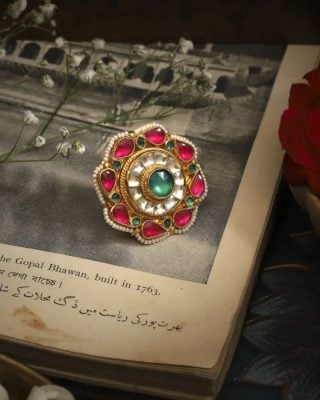
Finger rings might seem small, but they do a lot of work. A bold statement ring can make your whole look stand out. Or you can stack multiple thin bands for a layered effect.
If you’re wearing a necklace with polki, go for rings in a similar style to stay coordinated. Many brides choose rings that match their earrings or maang tika for a more polished finish. Whether it’s a single standout ring or several subtle ones, this detail shows up in all your hand photos, from rituals to candid shots. Take the time to get this one right.
10. Toe Rings (Bichhiya)
Toe rings are traditional, especially in North and South Indian weddings. You’ll wear one on each second toe, usually placed by your partner during the ceremony. The designs can be simple or engraved with subtle patterns. While you may not see them in every photo, they hold deep personal and cultural meaning.
Choose comfortable ones that fit well. If your outfit includes sandals or open-toed shoes, these rings become both a tradition and a visual detail.
Also Read: Jewelry: An Extension of Your Personality
11. Hathphool

Hathphool is a beautiful hand accessory worn by brides. It connects finger rings to a bracelet with delicate chains across the back of the hand. Hathphool looks lovely with mehendi. Brides can choose simple or detailed designs in gold, Polki, or pearls to match their overall bridal jewellery look.
Final Thoughts
Choosing your wedding bridal jewellery isn’t just about following a checklist. Every piece you wear reflects something about you—your roots, your style, and how you want to remember this day.
You don’t need to follow rules, but you should know what your options are. Mix bold with delicate. Blend traditional with personal. Whether you go for gold heirloom jewellery or modern silver gold plated jewellery, you can create a look that’s meaningful and unforgettable. With these different types of bridal jewellery, you’re not just dressing up. You’re creating a moment—one that lasts long after the wedding is over.
Meermankaa is your one-stop destination for Indian bridal jewellery! Find everything you need, like necklaces, earrings, rings, bangles, and more to complete your wedding look.
Frequently Asked Questions
1. What are the different types of Indian jewellery?
Indian jewellery includes kundan, polki, meenakari, temple, antique, pearl, and oxidized styles. Each type has its own design and cultural value. Gold and silver pieces are most common, while modern collections also include diamond and gemstone jewellery for festive, bridal, and everyday looks.
2. How to choose Indian bridal jewelry?
Choose bridal jewellery that matches your outfit’s color, neckline, and embroidery. For heavy lehengas, go for simpler pieces, and for plain outfits, try layered sets. Kundan, polki, or temple jewellery are great choices. Always balance comfort and design so it complements your bridal look.
3. What are popular bridal jewelry trends?
Bridal jewelry trends include layered necklaces, choker sets, and oversized earrings. Kundan and polki designs remain favorites, while pearls and colored gemstones add a modern look. Brides also love mixing gold with pastel tones for a royal and stylish appearance at weddings.
4. What are some modern South Indian bridal jewelry trends?
Modern South Indian brides are choosing lightweight temple jewellery, antique gold pieces, and gemstone chokers. Layered haram sets, waist belts, and maang tikkas are also popular. Many brides mix traditional gold designs with modern detailing for a fresh yet cultural wedding look.
5. What are the different types of South Indian jewelry?
South Indian jewellery includes temple, kasu mala, guttapusalu, haram, vanki, and oddiyanam. Temple jewellery features goddess motifs, while kasu mala has coin designs. Guttapusalu has pearl clusters, haram is a long necklace, vanki is an armlet, and oddiyanam is a waist belt for brides.
